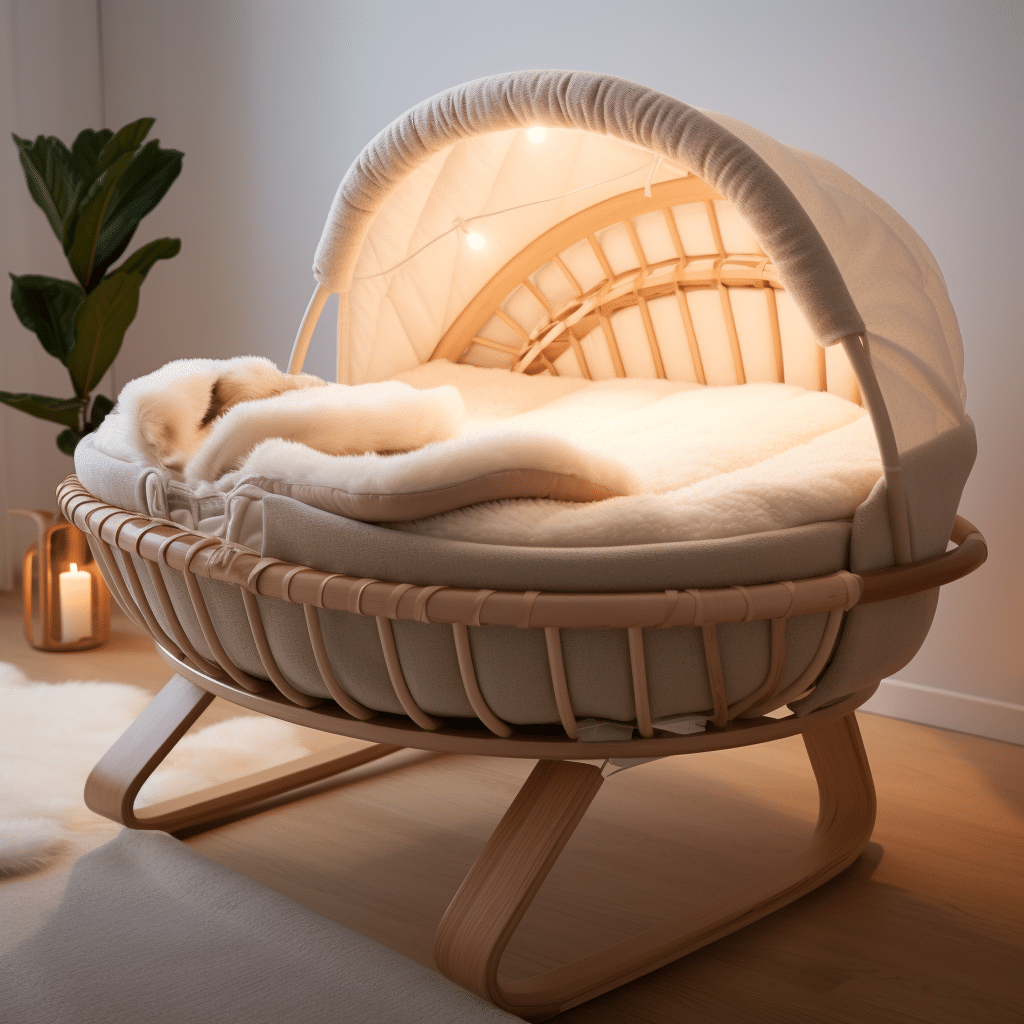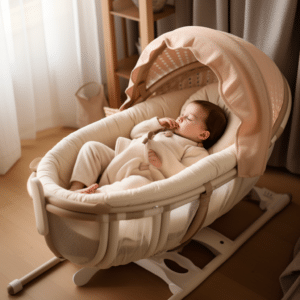
Creating a Comfortable Bassinet for Your Baby’s Sleep
Comfortable Bassinet for Baby Sleep: Sleep is essential for the physical and mental growth of babies. Every parent’s concern is how to make their infant safe and comfortable while sleeping. A safe sleeping area, including a bassinet, is every parent or caretaker’s responsibility.
Babies prefer to fall asleep in their mother’s arms and tend to wake up immediately after they are put down, and this can be frustrating to the mom. Babies spend most of their time asleep, and thus you will want to make your baby as comfortable as possible. An ideal bassinet mimics the womb for ease of transition for an infant.

How Can You Make a Bassinet Comfortable For Your Little One?
Get a Comfortable Bassinet
There are several types of bassinets in the market. Before purchasing one, you need to research the safety standards and reviews of the particular bassinet by other users. A bassinet should have a firm mattress and fitted sheets. The sides should be Comfortable Bassinet for Baby Sleep made of natural breathable fabrics with no added dye to protect your baby’s sensitive skin. There should be no gap between the sides of the mattress. Where possible avoid used bassinets.
Swaddle the Baby
Swaddling helps mimic the snugness of the womb. A bassinet can feel wide open, and babies may not like it. Other advantages of swaddling include; it moderates Moro Reflex that makes a newborn feel like they are falling hence interrupting their sleep, it alleviates colic, and mimics a hand’s touch. You should discontinue swaddling a baby when they start rolling.
Regulate Temperatures
Unfavorable temperatures can make a baby fail to sleep. Ensure the swaddle (for a baby who has not started rolling) or the wearable blanket (for those who have started rolling) can regulate heat. The beddings should wick moisture and keep the baby cool during hot weather and keep them warm enough when cold. Natural fabrics such as bamboo, cotton, and cotton are great in temperature regulation. Additionally do not overdress your baby. A few layers of clothing are enough to keep them warm. Touch the neck of the baby to check if the temperatures are okay; if sweaty reduce the heat, and if cold add a layer of clothing or heat.
Put The Baby Close to You
Putting the baby next to you makes it easy for a nighttime diaper change and feeding. It is also easy for close monitoring. Your baby gets reassured by your smell. Your baby knows what you smell like, and the more they can smell you, the better for them. You can try an old trick of rubbing your baby’s swaddling blanket on your chin to pick your scent.
Wash the Beddings Regularly
A bassinet should be very clean, bearing in mind that your baby spends most of their time sleeping. The sheets and swaddling blankets or wearable blankets should be free from dust and should be washed daily where possible. While purchasing beddings, it is paramount to ensure that they are easy to wash and durable to prevent tearing off after a few washes.
Have a Sleeping Routine
Sleeping routines are reassuring to babies and reinforce a natural circadian rhythm that helps them identify sleeping times. At first, it will seem hard but they will adapt to the routine. Activities such as breast or bottle feeding, a warm bath, or a lullaby before they sleep are a good start. Strive to always put your baby to sleep when they are still awake.
An ideal room should be dark and free from noises and distractions. Doctors recommend putting a baby to sleep on their back to reduce the risk of Sudden Infant Deaths (SIDs). Avoid too much play or stimulation before putting the little one to sleep.
How to Tell If Your Baby is Uncomfortable In a Bassinet
When your baby gets too fussy or takes longer to fall asleep, they might be uncomfortable in the bassinet. Shorter than usual sleep cycles and crying can also be signs of discomfort. If your baby starts coughing or sneezing after you put them down, there might be allergens in the bassinet or the room that makes the baby uncomfortable.
If you notice your baby wakes up looking tired and not fully refreshed, it might be an indicator that the child is uncomfortable. Sleeping in a comfortable bassinet helps them to wake up refreshed and rejuvenated.

Points to Note While Using a Bassinet
- When your baby exceeds the maximum weight or height recommended for the bassinet, he will be uncomfortable while sleeping there. Additionally, when a baby starts rolling, he should be transferred from a bassinet to avoid the risk of falling over.
- Do not cover the head while sleeping. This is a choking risk.
- Put the baby to sleep on his back. It ensures comfort and reduces the risk of SIDS.
- Remove soft objects such as stuffed toys, blankets, quilts, and corded pacifiers from the bassinet.
- Have a well-aerated, dust-free, and clean room that is quiet and free from distractions.
- Lock the wheels of bassinets that are movable.
- Consider offering a non-corded pacifier to a baby after they hit one month.
- Place the bassinet away from hazards such as windows, movable items, and anything that you may deem a risk to his safety.
- Place your baby feet first in the bassinet. Placing his head first makes him feel like he is falling and might wake up.
- Ensure the baby is well fed and the diaper is changed before putting him down.
- Be patient with the baby. It might take him time to get used to sleeping in the bassinet.
Comfortable Bassinet for Baby Sleep, a baby spends most of his time sleeping and thus requires a safe and comfortable sleeping-place. A bassinet is a good sleeping place for babies upto 4 months.It is light, small, and easy to carry around the house , and thus convenient for parents. However, for it to offer maximum comfort to the baby, it should be as comfortable as possible. Ensure it is clean and use the right beddings to achieve this comfort.